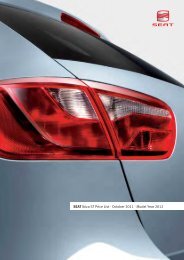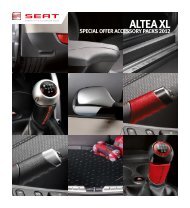WHAT'S THE DIFFERENCE BETWEEN STANDARD TYRES ... - Seat
WHAT'S THE DIFFERENCE BETWEEN STANDARD TYRES ... - Seat
WHAT'S THE DIFFERENCE BETWEEN STANDARD TYRES ... - Seat
Create successful ePaper yourself
Turn your PDF publications into a flip-book with our unique Google optimized e-Paper software.
KEY facts<br />
Why are winter tyres safer below 7°C?<br />
Winter tyres significantly improve grip and reduce<br />
stopping distances in temperatures below 7°C<br />
because, unlike standard tyres, they don’t<br />
harden. This enables them to maintain better<br />
traction in low temperatures, as well as in the wet<br />
and on snow, slush and ice, reducing the risk of<br />
aquaplaning and improving braking distance.<br />
Research undertaken by TyreSafe has clearly<br />
shown that stopping distances from 50mph on<br />
a cold, wet road are up to six metres shorter for a<br />
car using winter tyres compared with standard<br />
tyres – which is about the same length<br />
as a large family car.<br />
In snow, the difference between a winter tyre<br />
and a standard tyre is even more evident with<br />
stopping distances, braking and cornering<br />
performance all dramatically enhanced with<br />
winter tyres fitted. Stopping from just 20mph<br />
on an icy road can be improved by 11 metres –<br />
around the length of a bus.<br />
Don’t be put off by the additional<br />
COST of a second set of tyres<br />
The initial outlay is offset by the saving on<br />
wear to your standard tyres. Winter tyres wear<br />
up to 20% less than standard tyres during cold<br />
weather driving.<br />
(Source: www.tyresafe.org)<br />
Plus, if your tyres aren’t right for the conditions,<br />
your stopping distances are increased and<br />
you’re more likely to have an accident. If you<br />
claim on your insurance you could lose your no<br />
claims bonus – and the excess could be as<br />
much as the cost of a set of winter tyres.<br />
Use the right tyres for the conditions<br />
We advise against changing to winter tyres<br />
permanently as in warmer weather they’ll give<br />
you less grip, wear more quickly and lead to<br />
increased fuel costs.<br />
In some cases, the speed rating of the winter<br />
tyres fitted may be less than that of the standard<br />
tyres originally fitted.<br />
Braking distances on icy roads from 20mph (30km/h) to rest *<br />
WINTER <strong>TYRES</strong><br />
WINTER <strong>TYRES</strong><br />
<strong>STANDARD</strong> <strong>TYRES</strong><br />
<strong>STANDARD</strong> <strong>TYRES</strong><br />
57m<br />
57m<br />
11m<br />
11m<br />
68m<br />
68m<br />
Swapping to winter tyres<br />
between October and March<br />
will increase the lifespan of<br />
your standard tyres – saving<br />
you money in the long term.<br />
Winter tyre sidewall markings<br />
Severe snow<br />
conditions<br />
*Source: www.tyresafe.org<br />
Braking distances on snowy roads from 30mph (50km/h) to rest *<br />
35m<br />
WINTER <strong>TYRES</strong><br />
35m<br />
WINTER <strong>TYRES</strong><br />
<strong>STANDARD</strong> <strong>TYRES</strong><br />
<strong>STANDARD</strong> <strong>TYRES</strong><br />
8m<br />
8m<br />
43m<br />
43m<br />
<strong>STANDARD</strong> <strong>TYRES</strong><br />
WINTER <strong>TYRES</strong><br />
Mud and snow<br />
*Source: www.tyresafe.org

















